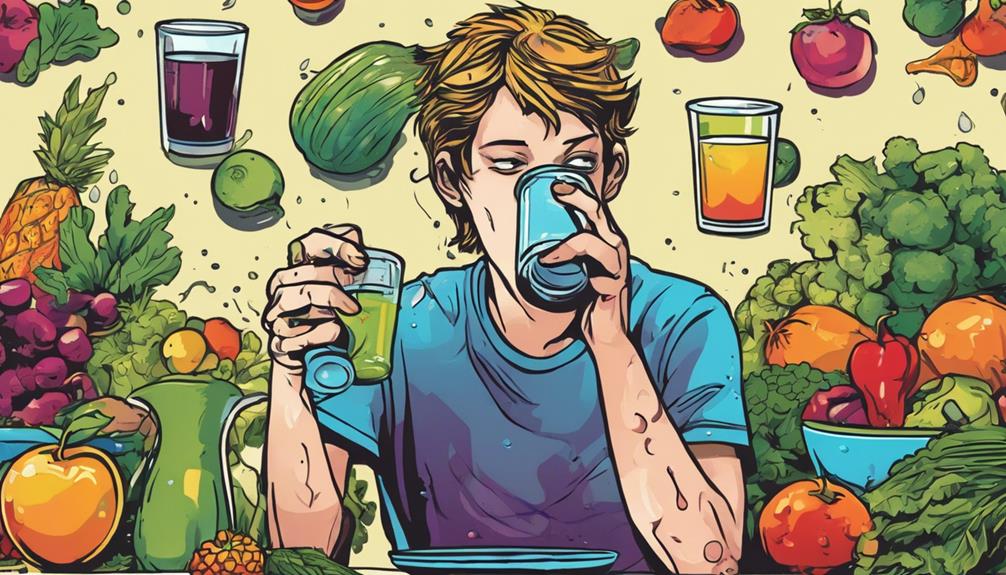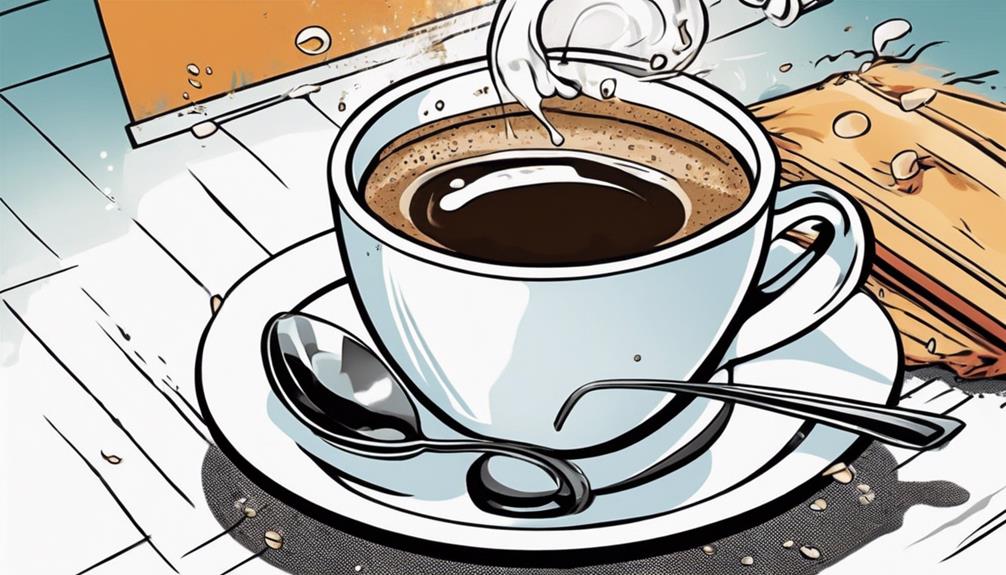In order to prevent coffee withdrawal symptoms, begin by reducing caffeine intake gradually. This can help reduce headaches, irritability, and fatigue. Stay well hydrated to flush out toxins and maintain energy levels. A well-rounded diet filled with essential nutrients can combat fatigue and stabilize emotions. Regular physical activity can lessen the severity of symptoms, boost mood, and improve sleep patterns. Incorporating relaxation techniques such as deep breathing and mindfulness meditation can aid in adjustment. By reducing coffee consumption weekly and replacing a cup with decaf or herbal tea, one can ease the transition. Remember to stay hydrated, keep track of other sources of caffeine, and engage in calming activities. By following these steps, you can avoid withdrawal symptoms and transition smoothly. You may also want to consider using caffeine tracking with MyFitnessPal to monitor and gradually decrease your caffeine intake. This tool can help you become more aware of your habits and set achievable goals for reducing your reliance on coffee. With a proactive and systematic approach, you can successfully overcome coffee withdrawal symptoms and embrace a healthier lifestyle.
Key Takeaways
- Gradually reduce caffeine intake to minimize withdrawal symptoms.
- Stay hydrated to alleviate headaches and fatigue during the transition.
- Maintain a balanced diet to support stable emotions and energy levels.
- Engage in regular physical activity to boost mood and combat lethargy.
- Practice relaxation techniques like deep breathing and meditation to manage discomfort.
Gradually Reducing Caffeine Intake
To minimize coffee withdrawal symptoms, start by gradually reducing your caffeine intake over a period of adjustment. Withdrawal symptoms such as headaches, irritability, and fatigue can be lessened by slowly tapering off your caffeine consumption.
By allowing your body to adjust to lower levels of stimulation, the shift can be smoother. Sudden cessation of caffeine can result in more severe withdrawal symptoms compared to a gradual reduction.
To implement a successful step-by-step plan, consider gradually cutting back on caffeinated beverages over several weeks. This approach can help you avoid the abrupt onset of withdrawal symptoms that can occur when quitting suddenly.
Hydration and Balanced Diet Support

Staying adequately hydrated and maintaining a balanced diet can play an essential role in easing coffee withdrawal symptoms. Hydration is key in flushing out toxins and supporting bodily functions, reducing the severity of headaches and fatigue often experienced during withdrawal. A balanced diet rich in nutrients from fruits, vegetables, lean proteins, and healthy fats can provide sustained energy levels without the need for coffee. Additionally, proper hydration and nutrition can help regulate mood swings and cravings that commonly arise during coffee withdrawal.
| Benefits of Hydration and Balanced Diet Support | ||
|---|---|---|
| Benefit | Description | Effect |
| Hydration | Helps flush out toxins | Reduces headaches |
| Balanced Diet | Provides essential nutrients | Decreases fatigue |
| Mood Regulation | Supports stable emotions | Reduces mood swings |
| Energy Levels | Sustained without coffee | Combats fatigue |
| Craving Control | Helps manage cravings | Supports withdrawal |
Regular Physical Activity Benefits

Incorporating regular physical activity into your routine can greatly alleviate the severity of coffee withdrawal symptoms. Engaging in exercise helps reduce the intensity of withdrawal symptoms, such as headaches and irritability, by boosting endorphins that improve mood and alleviate fatigue.
Additionally, physical activity promotes better sleep patterns, which can be disrupted during caffeine withdrawal, further aiding in managing withdrawal-related sleep disturbances. Regular workouts not only increase energy levels but also combat the lethargy often experienced when cutting back on coffee.
By staying active, you can distract yourself from caffeine cravings and provide a healthy outlet for stress relief, making the adjustment period smoother. Remember that even light exercises like walking or yoga can make a significant difference in how you feel during this shift.
Relaxation Techniques for Adjustment

Engage in relaxation techniques such as deep breathing exercises and progressive muscle relaxation to aid in adjusting to the effects of caffeine withdrawal.
Deep breathing exercises help calm your nervous system, reducing the intensity of caffeine withdrawal symptoms.
Progressive muscle relaxation techniques can decrease tension in your body, promoting a sense of relaxation during this adjustment period.
Moreover, practicing mindfulness meditation allows you to stay present and effectively manage the discomfort associated with caffeine withdrawal.
Consider incorporating aromatherapy into your routine with calming scents like lavender or chamomile to alleviate anxiety and stress levels.
Additionally, gentle yoga or stretching routines can help release physical tension, further supporting your relaxation efforts.
Mindful Approach to Lower Caffeine Intake

To decrease your caffeine intake mindfully, gradually reducing your daily coffee consumption by 25% each week is recommended. This gradual decrease can help reduce the chances of experiencing withdrawal symptoms.
Consider swapping one cup of coffee with decaf or herbal tea to ease the shift to lower caffeine consumption. It's crucial to stay hydrated with water throughout this process to combat any mild headaches or fatigue that may arise from reducing coffee intake.
Additionally, monitor your caffeine intake from other sources like energy drinks and chocolate to ensure a mindful approach to reducing overall consumption. Engaging in calming activities such as yoga or meditation can also be beneficial in managing stress during the caffeine reduction process.
Frequently Asked Questions
How Do You Prepare for Caffeine Withdrawal?
To prepare for caffeine withdrawal, first, gradually reduce your intake. Stay hydrated, exercise regularly, prioritize sleep, and consider herbal teas. These steps can help minimize symptoms like headaches and fatigue, making the shift away from coffee smoother.
How Long Does It Take to Feel Normal After Quitting Caffeine?
To feel normal after quitting caffeine, it typically takes 2-9 days. Symptoms peak around 24-51 hours after your last intake. Factors like intake level and metabolism play a role. Hydration, rest, and healthy eating can help speed up recovery.
How to Stop Caffeine Withdrawal Headaches?
To stop caffeine withdrawal headaches, gradually decrease caffeine intake, stay hydrated, take over-the-counter pain relievers, practice relaxation techniques like deep breathing, and make sure you get enough rest. These steps can help alleviate symptoms effectively.
Is Caffeine Withdrawal a Syndrome?
Yes, caffeine withdrawal is indeed a syndrome with specific symptoms like headaches, fatigue, irritability, and concentration difficulties. It affects around 50% of regular caffeine consumers, typically starting within 12-24 hours after the last dose.
Conclusion
As you navigate the path to reducing your caffeine intake, remember that it's like a winding river flowing towards a calm lake. By gradually decreasing your caffeine consumption, staying hydrated, staying active, practicing relaxation techniques, and being mindful, you can avoid those pesky coffee withdrawal symptoms.
Keep your eyes on the horizon and remember that with each step forward, you're one step closer to a smoother shift. Keep going, you've got this!









